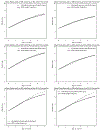Can following formula-feeding recommendations still result in infants who are overweight or have obesity?
- PMID: 32179869
- PMCID: PMC7492437
- DOI: 10.1038/s41390-020-0844-3
Can following formula-feeding recommendations still result in infants who are overweight or have obesity?
Abstract
Background: Studies show that by 3 months, over half of US infants receive formula, and guidelines play a key role in formula feeding. The question then is, what might happen if caregivers follow guidelines and, more specifically, are there situations where following guidelines can result in infants who are overweight/have obesity?
Methods: We used our "Virtual Infant" agent-based model representing infant-caregiver pairs that allowed caregivers to feed infants each day according to guidelines put forth by Johns Hopkins Medicine (JHM), Children's Hospital of Philadelphia (CHOP), Children's Hospital of the King's Daughters (CHKD), and Women, Infants, and Children (WIC). The model simulated the resulting development of the infants from birth to 6 months. The two sets of guidelines vary in their recommendations, and do not provide studies that support amounts at given ages.
Results: Simulations identified several scenarios where caregivers followed JHM/CHOP/CHKD and WIC guidelines, but infants still became overweight/with obesity by 6 months. For JHM/CHOP/CHKD guidelines, this occurred even when caregivers adjusted feeding based on infant's weight. For WIC guidelines, when caregivers adjusted formula amounts, infants maintained healthy weight.
Conclusions: WIC guidelines may be a good starting point for caregivers who adjust as their infant grows, but the minimum amounts for JHM/CHKD/CHOP recommendations may be too high.
Impact: Our virtual infant simulation study answers the question: can caregivers follow current formula-feeding guidelines and still end up with an infant who is overweight or has obesity? Our study identified several situations in which unhealthy weight gain and/or weight loss could result from following established formula-feeding recommendations. Our study also suggests that the minimum recommended amount of daily formula feeding should be lower for JHM/CHOP/CHKD guidelines to give caregivers more flexibility in adjusting daily feeding levels in response to infant weight. WIC guidelines may be a good starting point for caregivers who adjust as their infant grows. In order to understand how to adjust guidelines, we can use computational simulation models, which serve as "virtual laboratories" to help overcome the logistical and ethical issues of clinical trials.
Conflict of interest statement
Figures


Comment in
-
The potential impact of feeding formula-fed infants according to published recommendations.Pediatr Res. 2020 Oct;88(4):526-528. doi: 10.1038/s41390-020-1056-6. Epub 2020 Jul 7. Pediatr Res. 2020. PMID: 32634816 No abstract available.
References
-
- Grummer-Strawn LM, Scanlon KS, Fein SB 2008. Infant feeding and feeding transitions during the first year of life. Pediatrics 122 Suppl 2:S36–42. - PubMed
-
- Division of Nutrition PA, and Obesity, National Center for Chronic Disease Prevention and Health Promotion, Centers for Disease Control and Prevention, 2018 Breastfeeding Report Card: United States, 2018. U.S. Department of Health and Human Services.
-
- Marchand L, Morrow M 1994. Infant feeding practices: understanding the decision-making process. Family medicine 26:319–324. - PubMed
-
- Cairney PA, Alder EM, Barbour RS 2006. Support for infant feeding: mothers’ perceptions. British Journal of Midwifery 14:694–700.
Publication types
MeSH terms
Grants and funding
LinkOut - more resources
Full Text Sources
Medical
Research Materials

